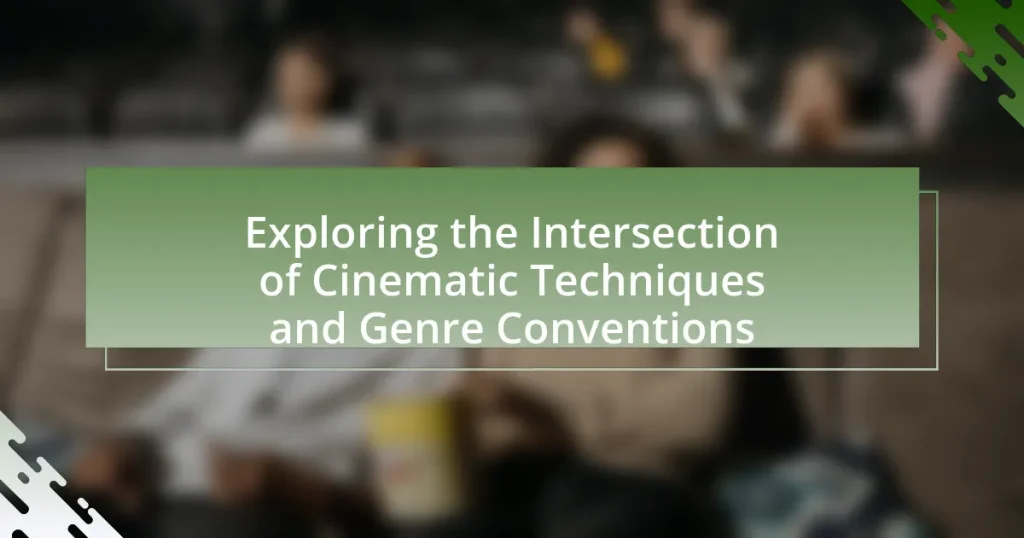The article examines the intersection of cinematic techniques and genre conventions, highlighting how filmmakers utilize methods such as camera angles, lighting, sound design, and editing to enhance storytelling and evoke emotions. It discusses the role of genre conventions in shaping audience expectations and the importance of adhering to or subverting these norms to create engaging narratives. Key cinematic techniques, their influence on viewer experience, and the challenges filmmakers face when blending innovation with established conventions are also explored. The article emphasizes the significance of understanding this intersection for improving filmmaking practices and audience engagement.

What are Cinematic Techniques and Genre Conventions?
Cinematic techniques are the methods filmmakers use to convey stories and emotions visually, including elements like camera angles, lighting, sound, and editing. Genre conventions are the established norms and characteristics that define specific film genres, such as themes, narrative structures, and stylistic elements. For example, horror films often utilize low lighting and suspenseful music to create tension, while romantic comedies typically feature light-hearted dialogue and happy endings. These techniques and conventions work together to shape audience expectations and enhance storytelling, as evidenced by the consistent use of specific visual styles in genres like film noir or action films.
How do cinematic techniques influence storytelling in films?
Cinematic techniques significantly influence storytelling in films by shaping the narrative structure, emotional tone, and audience engagement. Techniques such as camera angles, lighting, editing, and sound design create a visual and auditory language that conveys themes and character development. For instance, the use of close-up shots can intensify emotional moments, while non-linear editing can create suspense or reveal character backstories in a more impactful way. Research indicates that films employing innovative cinematic techniques, like those seen in “Inception” directed by Christopher Nolan, effectively manipulate audience perception and enhance storytelling depth, demonstrating the critical role these techniques play in narrative construction.
What are the key cinematic techniques used in filmmaking?
Key cinematic techniques used in filmmaking include cinematography, editing, sound design, mise-en-scène, and lighting. Cinematography involves the composition and movement of shots, influencing how viewers perceive the story. Editing shapes the narrative flow and pacing, with techniques like continuity editing and montage creating emotional impact. Sound design enhances the atmosphere and realism, incorporating dialogue, sound effects, and music to support the visual elements. Mise-en-scène encompasses the arrangement of scenery, props, and actors, contributing to the film’s overall aesthetic and thematic depth. Lighting sets the mood and highlights important elements, using techniques such as high-key and low-key lighting to evoke specific emotions. Each of these techniques plays a crucial role in storytelling and audience engagement, as evidenced by their consistent application across successful films in various genres.
How do these techniques enhance the viewer’s experience?
Cinematic techniques enhance the viewer’s experience by creating emotional engagement and immersive storytelling. Techniques such as camera angles, lighting, and sound design manipulate the audience’s perception and evoke specific feelings, making the narrative more compelling. For instance, a study by Bordwell and Thompson in “Film Art: An Introduction” illustrates how close-up shots can intensify emotional responses by focusing on characters’ expressions, thereby deepening viewer empathy. Additionally, the use of genre conventions, like suspenseful music in thrillers, heightens tension and anticipation, further enriching the viewing experience.
What role do genre conventions play in film production?
Genre conventions play a crucial role in film production by providing a framework that guides storytelling, visual style, and audience expectations. These conventions help filmmakers establish a recognizable identity for their films, allowing them to communicate themes and emotions effectively. For instance, horror films often utilize dark lighting, suspenseful music, and jump scares to evoke fear, while romantic comedies typically feature light-hearted dialogue and happy endings to elicit laughter and joy. The adherence to these conventions can significantly influence a film’s reception, as audiences often seek specific elements associated with their preferred genres. Research indicates that films aligning closely with established genre conventions tend to perform better at the box office, as they meet audience expectations and enhance viewer engagement.
How do genre conventions shape audience expectations?
Genre conventions shape audience expectations by establishing a framework of familiar themes, narrative structures, and stylistic elements that viewers anticipate in specific genres. For instance, in horror films, conventions such as suspenseful music, dark settings, and the presence of a villain create an expectation of fear and tension. Research indicates that audiences often rely on these conventions to navigate and interpret films, as they provide cues about the emotional and narrative journey they are likely to experience. This reliance on genre conventions is supported by studies showing that viewers often rate films more favorably when they meet established genre expectations, highlighting the significant role these conventions play in shaping audience perceptions and experiences.
What are the common genre conventions across different film genres?
Common genre conventions across different film genres include narrative structure, character archetypes, thematic elements, and visual styles. Narrative structure often follows a three-act format, where the setup, confrontation, and resolution are clearly defined, allowing audiences to anticipate plot developments. Character archetypes, such as the hero, mentor, and villain, recur across genres, providing familiar roles that guide audience expectations. Thematic elements, including love, conflict, and morality, resonate universally, allowing films to explore complex ideas within various contexts. Visual styles, such as lighting, color palettes, and camera angles, are tailored to evoke specific emotions and enhance storytelling, with horror films often using low lighting to create suspense, while comedies may employ bright colors to convey a lighthearted tone. These conventions help establish genre identity and facilitate audience engagement.

How do Cinematic Techniques and Genre Conventions Interact?
Cinematic techniques and genre conventions interact by shaping the narrative and emotional impact of a film. Cinematic techniques, such as camera angles, lighting, and editing, are employed to enhance the storytelling inherent in specific genres. For example, horror films often utilize low lighting and quick cuts to create tension, while romantic comedies may use bright lighting and smooth transitions to evoke a lighthearted atmosphere. This interaction is evident in films like “Psycho,” where Alfred Hitchcock’s use of suspenseful editing and stark contrasts in lighting aligns with the conventions of the thriller genre, effectively heightening the viewer’s emotional response. Thus, the synergy between cinematic techniques and genre conventions is crucial for delivering a cohesive and engaging cinematic experience.
In what ways do cinematic techniques reinforce genre conventions?
Cinematic techniques reinforce genre conventions through the use of specific visual styles, sound design, and editing patterns that align with audience expectations. For instance, horror films often employ low lighting and dissonant sound effects to create tension, while romantic comedies typically utilize bright colors and upbeat music to evoke a lighthearted atmosphere. These techniques are not arbitrary; they are rooted in historical practices that have shaped audience perceptions over time. Research indicates that viewers develop genre-specific expectations based on these established techniques, which can enhance their emotional engagement and satisfaction with the film.
How does the use of specific techniques define a genre?
The use of specific techniques defines a genre by establishing recognizable patterns and conventions that audiences associate with particular types of narratives. For instance, horror films often employ techniques such as suspenseful music, dim lighting, and sudden jump scares to evoke fear, while romantic comedies typically utilize light-hearted dialogue, upbeat music, and comedic timing to create a sense of joy and connection. These techniques not only shape the viewer’s emotional response but also help categorize films into distinct genres, making it easier for audiences to select content that aligns with their preferences. The consistent application of these techniques across various works reinforces genre identity, as seen in the way film noir utilizes shadowy cinematography and morally ambiguous characters to create a specific atmosphere.
What examples illustrate the interaction between techniques and conventions?
Examples illustrating the interaction between techniques and conventions include the use of handheld camera work in horror films, which enhances the sense of realism and immediacy, aligning with the genre’s convention of creating tension and fear. Additionally, the incorporation of non-linear storytelling in thrillers, such as in “Pulp Fiction,” challenges traditional narrative conventions while employing editing techniques that create suspense and intrigue. These examples demonstrate how specific cinematic techniques can effectively engage with and redefine genre conventions, enhancing the overall impact of the film.
What challenges arise from blending cinematic techniques with genre conventions?
Blending cinematic techniques with genre conventions presents challenges such as audience expectation misalignment and narrative coherence issues. When filmmakers employ innovative cinematic techniques, they risk alienating audiences who anticipate specific genre tropes, leading to confusion or dissatisfaction. For instance, a horror film that utilizes a romantic narrative style may disrupt the expected tension and fear, resulting in a diluted emotional impact. Additionally, integrating diverse cinematic styles can complicate the narrative structure, making it difficult for viewers to follow the storyline. This complexity can detract from the overall effectiveness of the film, as seen in projects that attempt to merge genres without a clear vision, often resulting in critical and commercial failure.
How can filmmakers balance innovation with genre expectations?
Filmmakers can balance innovation with genre expectations by creatively integrating new techniques while adhering to established conventions. This approach allows filmmakers to introduce fresh narratives or visual styles that engage audiences without alienating them. For instance, the use of non-linear storytelling in films like “Pulp Fiction” innovatively reshaped the crime genre while still maintaining core elements such as suspense and character archetypes. By analyzing audience expectations and genre tropes, filmmakers can identify areas for innovation that enhance the viewing experience while respecting the genre’s foundational aspects.
What are the risks of subverting genre conventions through cinematic techniques?
Subverting genre conventions through cinematic techniques carries the risk of alienating audiences who have specific expectations based on established genre norms. When filmmakers deviate from these conventions, they may confuse viewers, leading to a disconnect between the narrative and audience engagement. For instance, a horror film that lacks traditional suspense elements may fail to evoke fear, resulting in negative reception. Additionally, subversion can lead to misinterpretation of the film’s themes, as audiences may struggle to grasp the intended message without familiar genre cues. Historical examples, such as the mixed reviews for “The Last Jedi,” illustrate how subverting expectations can polarize audiences and impact box office performance.

What are the Implications of This Intersection for Filmmakers?
The implications of the intersection of cinematic techniques and genre conventions for filmmakers include the ability to innovate storytelling and enhance audience engagement. By blending various cinematic techniques, such as unique camera angles, editing styles, and sound design, filmmakers can create a distinctive narrative experience that resonates with viewers. For instance, the use of non-linear storytelling in genres like thriller or drama can heighten suspense and emotional impact, as seen in films like “Pulp Fiction.” This intersection allows filmmakers to challenge traditional genre boundaries, leading to fresh interpretations and broader audience appeal. Additionally, understanding genre conventions enables filmmakers to meet audience expectations while simultaneously subverting them, as demonstrated in films like “Get Out,” which combines horror with social commentary. This strategic use of cinematic techniques within genre frameworks ultimately enhances the storytelling potential and marketability of films.
How can understanding this intersection improve filmmaking practices?
Understanding the intersection of cinematic techniques and genre conventions can significantly enhance filmmaking practices by enabling filmmakers to create more engaging and resonant narratives. This understanding allows filmmakers to effectively utilize specific techniques that align with genre expectations, thereby enhancing audience immersion and emotional impact. For instance, employing suspenseful editing techniques in a thriller can heighten tension, while vibrant color palettes in a romantic comedy can evoke joy. Research indicates that films that skillfully blend these elements tend to achieve higher audience satisfaction and box office success, as evidenced by the critical acclaim and commercial performance of genre-defining films like “Get Out,” which combines horror with social commentary.
What strategies can filmmakers use to effectively combine techniques and conventions?
Filmmakers can effectively combine techniques and conventions by employing a hybrid approach that integrates elements from different genres while maintaining a cohesive narrative. This strategy allows filmmakers to leverage the strengths of various cinematic techniques, such as blending visual styles, sound design, and editing rhythms, to enhance storytelling. For instance, the use of non-linear storytelling, often found in thrillers, can be combined with the emotional depth of drama to create a more engaging viewer experience.
Additionally, filmmakers can draw on established genre conventions to subvert audience expectations, as seen in films like “Get Out,” which combines horror with social commentary, effectively utilizing both horror tropes and satirical elements. This blending not only enriches the narrative but also broadens the film’s appeal across different audience demographics. By strategically merging these techniques and conventions, filmmakers can create innovative works that resonate on multiple levels, demonstrating the versatility and adaptability of cinematic storytelling.
How can filmmakers analyze audience reactions to their choices?
Filmmakers can analyze audience reactions to their choices through various methods, including audience surveys, focus groups, and social media analysis. Audience surveys provide quantitative data on viewer preferences and emotional responses, while focus groups allow for in-depth discussions that reveal nuanced insights into audience perceptions. Social media analysis enables filmmakers to gauge real-time reactions and sentiments expressed by viewers, often using sentiment analysis tools to quantify opinions. Research indicates that understanding audience feedback can enhance future projects, as evidenced by a study published in the Journal of Media Psychology, which found that films that actively engage with audience feedback tend to perform better at the box office.
What are some best practices for utilizing cinematic techniques within genre frameworks?
Best practices for utilizing cinematic techniques within genre frameworks include aligning visual storytelling with genre conventions, employing specific camera angles and lighting to evoke the desired emotional response, and using sound design to enhance the narrative. For instance, horror films often utilize low lighting and close-up shots to create tension, while romantic comedies typically favor bright lighting and wide shots to convey warmth and openness. Research indicates that these techniques significantly impact audience engagement and emotional resonance, as demonstrated in studies analyzing viewer reactions to different cinematic styles across genres.
How can filmmakers ensure their work resonates with genre-savvy audiences?
Filmmakers can ensure their work resonates with genre-savvy audiences by adhering to established genre conventions while also introducing innovative elements that surprise and engage viewers. Understanding the specific tropes, themes, and stylistic choices that define a genre allows filmmakers to meet audience expectations, as evidenced by the success of films like “Get Out,” which blends horror with social commentary, thereby appealing to both genre enthusiasts and broader audiences. By analyzing audience feedback and box office performance, filmmakers can refine their approach, ensuring that their narratives are both familiar and fresh, ultimately enhancing viewer satisfaction and engagement.
What common pitfalls should filmmakers avoid when navigating this intersection?
Filmmakers should avoid the pitfall of neglecting genre conventions while experimenting with cinematic techniques. This oversight can lead to confusion among audiences, as films that stray too far from established genre expectations may fail to resonate. For instance, a horror film that lacks suspenseful pacing or a clear sense of threat may alienate viewers who anticipate traditional horror elements. Additionally, filmmakers should be cautious of overcomplicating narratives with excessive stylistic choices, which can detract from the story’s clarity and emotional impact. Balancing innovation with genre fidelity is crucial for maintaining audience engagement and ensuring that the film communicates its intended message effectively.




